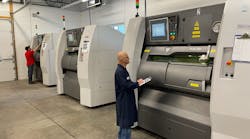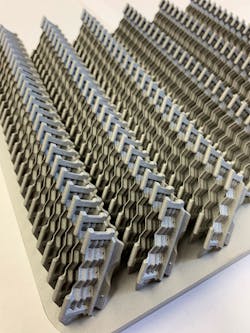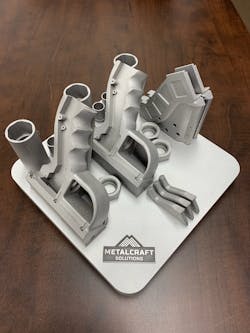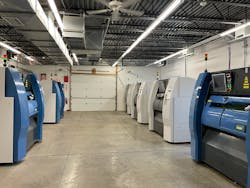When the engineers at Metalcraft Solutions, formerly Acro Tool and Die, set out to learn the science of additive manufacturing it was to serve the traditional book of business that had fueled the company for over 60 years. They did not get the results they expected but may have set the stage for decades’ worth of future successes.
Akron, Ohio, known as the Rubber City and birthplace of B. F. Goodrich, Goodyear, Firestone and Cooper was still at the heart of America’s tire mold manufacturing industry when Acro Tool and Die was founded in 1951. “It was a great book of business for a long, long time,” says Terry Ellis, general manager at Metalcraft Solutions. “The tire mold industry was centered in Akron, Ohio, and we had a strong position providing those types of components.”
Sipes, or kerfs, thin slots molded into tread blocks, were one mainstay product for Acro Tool and Die. As tire technology evolved, sipe geometry grew increasingly complex such that traditional stamp and press manufacturing was increasingly difficult to employ for the task. By 2012, Ellis knew trusting the fate of his company solely to traditional manufacturing methods was not tenable. It needed something new. That meant taking a risk.
Only Additive Manufacturing Fit the Mold
In the 1990s, the company put a foundry in the shop to try and accommodate new geometries through an investment casting process. It proved impractical. Ellis watched the development of 3D metal printing, witnessed other companies in the tire mold industry beginning to adapt the technology, and in 2012 decided to take the plunge with the purchase of a PXL-model laser bed fusion machine from French manufacturer Phenix, a company bought a year later by additive manufacturing giant 3D Systems.
“The tire mold industry likes smooth parts and that was what we were really waiting for,” says Ellis. “We were waiting for the best surface finish that we could find in the additive manufacturing metal category. The Phenix machine seemed to provide that best possible finish we could get. So we bought the first machine, the PXL, we put it in place and we started trying to overcome the foibles of additive manufacturing.”
A mechanical engineer by education, due to his background as a pattern maker and wariness of potential competition from the technology, Ellis had watched the progress of additive manufacturing since the mid-to-late ‘80s. One year prior to purchasing the machine from Phenix, Ellis had fortuitously hired an engineering manager straight out of college that was enthusiastic about cutting edge technology. Neither man feared the challenge of learning how to use the new machine.
Ellis describes the learning process as akin to repeatedly running into a brick wall. Powder bed fusion employs precision movement akin to a CNC mill, an environmental system that floods the chamber with inert gas, a unique powder delivery system and a mirror-based laser system. Ellis and his engineering manager had to tackle all four systems the very first time they deployed their new machine.
“That’s a lot to take on in one shot. And especially in 2012, the additive manufacturing of metal was still pretty young,” Ellis says. “Honestly, the folks who sold us the machine, they did a great job of selling the machine. They really didn't know how to run the technology. They were counting on their applications guys [who] didn’t know our tech. They didn’t know our geometry.
“So, as we set out to try and get the geometries we wanted to build successfully, if we ran into trouble we’d call the apps guys, and they weren’t really of any help. So you go to the internet, and you go ‘Okay, who else is doing this?’ when nobody’s talking. If they are doing it, no one's sharing their experience. So, you just hit the wall. You fall down, you back up, you look for a crack. You take another run at the wall and you just keep hitting the wall. But eventually those cracks start to open up.”
Additive Manufacturing Does Not Subtract Jobs
The declining book of business from tire mold manufacturing, as the industry recentered itself away from Akron, made personnel at Acro Tool and Die available to transfer to the additive side of the company. Buy-in on the shop floor was not seamless.
Because Ellis had wondered during his time as a pattern maker whether additive technology would wipe out his trade, he understood how a press operator could look at a machine that completely eliminated the forming process and wonder if it meant the end of their career.
“We had to sell it, really, to the rest of the shop,” Ellis says. “The way that we conveyed the necessity for it was that the principal industry that we were serving, they wanted this technology, or at least they wanted geometries that would require this technology. And that was undeniable.
“Also, as the orders started coming in from the tire mold industry specifically that wanted additive manufacturing components, not all of the parts on that order would be additively manufactured. There might be 60 parts on the order and only one or two of them were going to be additive. The rest of them were going to be conventional. If we didn’t acquire the additive technology, we were going to lose that entire order,” Ellis says.
“So we had to convince everyone who operated presses that we’re using the additive manufacturing to try and keep the presses busy,” Ellis says. “It wasn’t a hard sell. Honestly, it didn’t take long. When the orders started to come in that required both technologies, it was easy to point out that this is why we took on the new technology.”
Finding Additional Supply Chains and Time
Acro Tool and Die already had in place many of the supporting technologies desirable or required for additive manufacturing, like wire electrical discharge machining (EDM) centers to cut 3d-printed parts off build plates, Blanchard and surface grinding and shot peening and glass bead sandblasting. The company did not, however, have prior experience with powdered metal, the chief component in laser bed fusion.
The lateral production cost required going through a series of suppliers until settling on the final, current two and purchasing larger-than-expected quantities of powder, in this case 80-pound bags, to experiment with different materials.
“After we went through the initial idea that ‘Oh wow, we can make all these different materials for different people,’ after so many purges and so many containers with 80 pounds of material that we’re never going to use again stacking up in the shop, we said ‘Alright, that’s enough of that. We’re going to make pH 17-4 [stainless steel] and if someone else needs something else, I’m sorry but we we’re not the guys," says Ellis. Although, the company since then has begun working with several other materials as its additive business expanded.
Purging additive manufacturing machines in order to switch to a new building material may take days, resulting in temporal as well as financial costs for experimentation and learning how to effectively deploy the new machines.
“Can you afford to set a very expensive piece of technology on your shop floor, put a couple of relatively expensive employees on the project of making it productive, and then watch them beat their head against the wall for six months until you actually start to turn a dollar on it?” says Ellis. “If you don’t have that kind of financial wherewithal, you’ll have a hard time taking on the technology.”
Additive Manufacturing Attracts, Traditional Manufacturing Binds
A year and a half later, the company purchased two additional machines from Phenix, allowing Acro Tool and Die to keep specific machines loaded with specific material and cut down on purging time. It also provided redundancy in case of breakdowns. The next three machines came from a less expected source: companies that didn’t get the results they were looking for from the technology.
“The last three machines that we purchased were machines that came from companies here in Northeast Ohio. We had engaged all three of those companies at different times either to offer that we could build additive parts for them, or that we could offer additive capacity for them,” Ellis says. Instead, the companies sold their machines to Acro Tool and Die.
One of them was a tire manufacturer, another was an orthopedic medical device and implant manufacturer and the third company manufactures components for the space exploration and aerospace industry. Prior to the addition of additive manufacturing, Acro Tool and Die had only minimal medical and aerospace production in the shop.
“Eventually it became clear to them that it was not cost effective to maintain the technology in their facility, either the floor space or the personnel. It did not pan out for them,” Ellis says. “It certainly did pan out for us.”
Now, additive manufacturing serves as a hook to generate interest in the shop but by no means defines the company or what it has to offer new clients.
“We do business with a company that makes components for landscaping equipment. They make parts for John Deere. Honda, even, and they initially approached us for additive. But then they came for a shop tour and discovered that we had all these other technologies in house. We do more work with them using stamping and forming, laser cutting and CNC machining than we do additive manufacturing,” Ellis says.
The expansion into additive has also logistically, as well as financially, served the company’s traditional manufacturing efforts, for instance by cutting down on the time required to generate new tooling.
“That can be pretty significant really, to be able to additively manufacture, say a fixture to hold a part in the wire EDM,” Ellis says. “You need a particular angle or orientation for us to CNC mill a fixture for the wire EDM. It could take seven to 10 days [with traditional methods] and I could probably generate that same fixture in two days using the additive manufacturing.”
New Technology, New Brand
The company still calls itself Acro Tool and Die when talking to tire companies that know the name but for new customers, as of March 2020, Acro Tool and Die rebranded as Metalcraft Solutions, a formal recognition of how the company had evolved.
“In a way, we’re a 71-year-old startup because we have this mature foundation that we are now using to create the new endeavor of Metalcraft Solutions,” Ellis says. “And that’s a somewhat unique but beneficial position to be in. It’s not all new. We and all of the technologies that we have to support the additive, we’re well versed in, so it didn’t threaten our business to have this extremely difficult learning curve.
“Even the customers are learning what additive manufacturing can do for them. They’re learning what are the strengths, weaknesses, the capabilities and vulnerabilities…they really felt kind of like partners in adapting the technology to their parts and us learning how to use the technology to create their parts.”
In the end, did additive manufacturing live up to Ellis’s expectations? Yes, but not specifically for the tire mold industry, the reason his company invested in the first place. Sometimes embracing new technology opens unexpected doors and leads to unanticipated successes. It all comes down to taking the risk.
About the Author
Dennis Scimeca
Dennis Scimeca is a veteran technology journalist with particular experience in vision system technology, machine learning/artificial intelligence, and augmented/mixed/virtual reality (XR), with bylines in consumer, developer, and B2B outlets.
At IndustryWeek, he covers the competitive advantages gained by manufacturers that deploy proven technologies. If you would like to share your story with IndustryWeek, please contact Dennis at [email protected].




